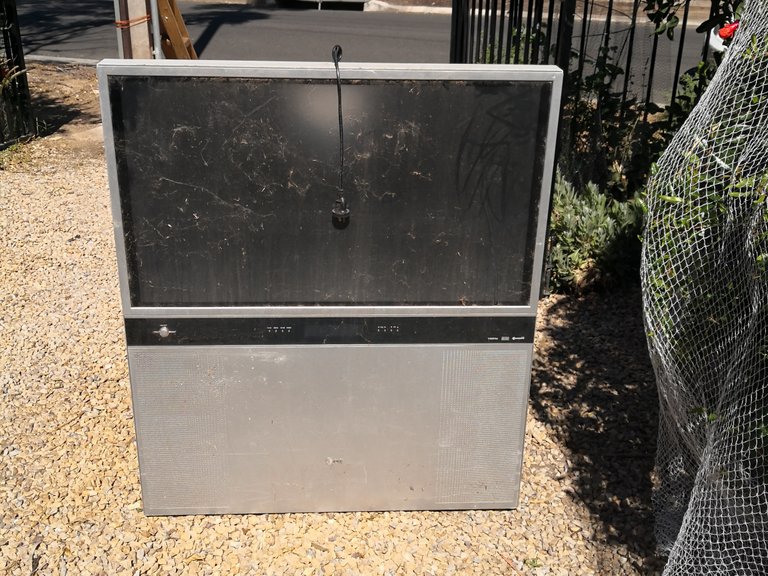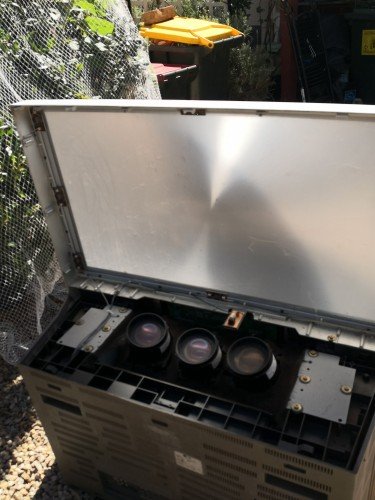DIY - taking a fresnel lens from an old TV
Hi Hive DIY and gardening enthusiasts! Here's another simple DIY project from Ligaya Garden.
This one is about getting Fresnel lenses from old rear projection TVs
Lets' have a look!

Fresnel lenses are fascinating things. They are used in a wide range of devices, from lighthouses to televisions. You can buy A4 sized fresnel lenses to help you read and can even get credit card sized lenses for the same purpose.
We’re interested in the ones we can scavenge from old, rear projection TVs. They are the front screen on these big beast and can easily be removed. If the TV has a solid glass front, it won't be one of these TVs. I find that running my fingernail over the front surface tells me if I've got the right kind or not. The surface will feel rough as your fingernail find the etching.

Fresnel lenses are used as one of the front components of the screens to increase the brightness of the viewing area. We use them to get the opposite effect.
When reversed, they gather light from a large area and focus it to a point or line.
These fresnel lenses are flat sheets of plastic with hundreds of concentric rings moulded into them. These rings capture the light and direct it towards a centre point, acting as a normal optical lens but having the advantage of being flat. Essentially, the curvature of a lens is broken up into angled rings and aid flat.
There are two kinds of fresnel lens – point focused and line focused. ‘Point focused’ act as we normally expect a lens to act, focusing light to a point. ‘Line focused’ focus the light to a line across the width of the lens.

Both kinds can be used for our purposes but it’s good to think of point focused lenses as being better at burning or rapid heating of a small area while line focused are better at slow heating.
Fresnel lenses don’t (as some folks mistakenly claim) increase the amount of light available. Like all lenses, they can only work with the light falling on their surface. Lenses merely redirect that light.
Another mistaken claim is that stacking fresnel lenses increases the amount of light and therefore heat that they output. Once again, they can only work with the light falling on them.
We’re interested in turning that light into heat by focusing it on an object and using the light’s energy to heat that object.
Being rather large and thin, the fresnel lenses we use are pretty floppy and are difficult to focus. Sometimes it’s tricky to find the best focal point and a big lens can get heavy when you’re holding it at arm’s length. . To overcome these issues, we need to use a frame to keep them flat and some sort of mount to keep them stable.
Wood is the best thing to make frames out of. The ones shown in the pic have aluminium brackets to hold the lens flat. You don’t need to be that extravagant and can use wood for both purposes.
Keep your frame light enough to move around. Make sure you measure the distance from lens to focal point to make focusing easier layer.
One tip is to allow a few millimetres gap around the edges of the lens. Being plastic, they can expand when warm and warp if that expansion is restricted.
I write the focal length on the side of the frame of each lens to aid my poor memory.
I’ve never got temperatures high enough to melt metal as some have on YouTube. It’s quite believable that you can do it though. I reckon it’s just that the lenses I’ve scrounge aren’t quite right for that purpose. One day I’ll buy some new ones and give them a try. Maybe I’ll even invest in some glass lenses.
What to do with one when you've removed it?
Think of a huge magnifying glass. You can focus the beam or line on anything you want to heat, such as a pot, kettle or solar oven. YouTube videos show folks using them to melt metals but I've not managed to get that kind of heat yet, One day, maybe!








That's really interesting.. nice tips! Thanks for sharing !1UP
Thanks! Plenty more good stuff to come. Is !1up a token that I will see in my wallet and be able to share around like !luv?
ONEUP is the main token of the 1UP community, but it's not a tipbot like !LUV or !PIZZA. The ! 1UP command is only used by Cartel curators to reward relevant posts on Hive.. You can read more about it HERE :)
@falcout(1/1) gave you LUV. wallet | market | tools | discord | community | <><
wallet | market | tools | discord | community | <><
Thanks! I get it now. I was curious because I sometimes get minscule amounts of ONEUP in my wallet and had received the trigger on my posts but saw nothing in my wallet. It makes good sense to have a trigger for curating.
!hivebits
Success! You mined .9 HBIT & the user you replied to received .1 HBIT on your behalf. mine | wallet | market | tools | discord | community | <><
What's HBIT?
You have received a 1UP from @falcout!
@ccc-curator, @stem-curator, @vyb-curator, @pob-curatorAnd they will bring !PIZZA 🍕
Learn more about our delegation service to earn daily rewards. Join the family on Discord.
Thanks @falcout ! Looking forward to !pizza to share!
PIZZA Holders sent $PIZZA tips in this post's comments:
@falcout(3/15) tipped @ligayagardener (x1)
curation-cartel tipped ligayagardener (x1)
You can now send $PIZZA tips in Discord via tip.cc!
Thank you!
Big screen TVs used to be extremely expensive. How much did that beast cost when it was new?
!wine
Congratulations, @yintercept You Successfully Shared 0.100 WINEX With @ligayagardener.
You Earned 0.100 WINEX As Curation Reward.
You Utilized 1/1 Successful Calls.
Contact Us : WINEX Token Discord Channel
WINEX Current Market Price : 0.250
Swap Your Hive <=> Swap.Hive With Industry Lowest Fee (0.1%) : Click This Link
Read Latest Updates Or Contact Us
I don't know the cost but lots of things like that are very pricey. I've only ever found them scrapped.
Your content has been voted as a part of Encouragement program. Keep up the good work!
Use Ecency daily to boost your growth on platform!
Support Ecency
Vote for new Proposal
Delegate HP and earn more
thank you!
I think a demonstration would be perfect! Is this how you make your morning cuppa?
@tipu curate
Upvoted 👌 (Mana: 12/42) Liquid rewards.
It's a lot of effort for a cuppa so early in the morning but I'm doing a video about it all on 3Speak soonish.
!luv
!hivebits
What's HBIT?
Success! You mined .9 HBIT and the user you replied to received .1 HBIT on your behalf. mine | wallet | market | tools | discord | community | <><
@ligayagardener(1/1) gave you LUV. wallet | market | tools | discord | community | <><
wallet | market | tools | discord | community | <><
Actually fascinating. I often see an old TV on the side of the road.
Aligning a few together into an array, offers some interesting cooking and water purifying possibilities. Smelting would take a few more, I expect.
Even a kiln, to fire clay creations. Off to youtube I go :)
Lots of possibilities but unfortunately you can't focus one into another. It would be great if you could. It's got to be a rear projection TV. not one with a tube or LCD screen.
I use it to focus some extra heat onto a box type solar oven or old style enamel kettle